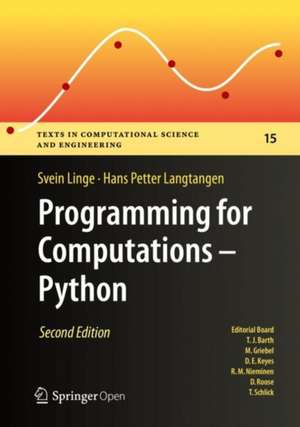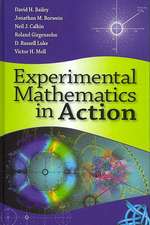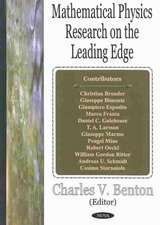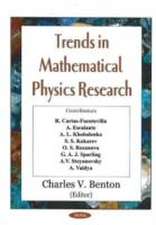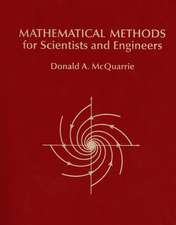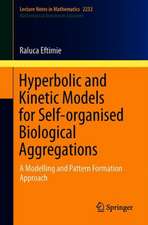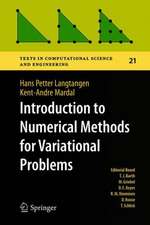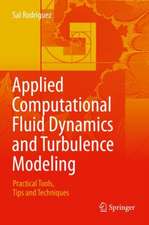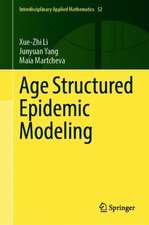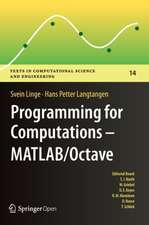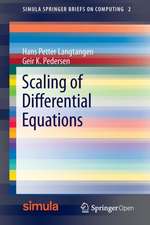Programming for Computations - Python: A Gentle Introduction to Numerical Simulations with Python 3.6: Texts in Computational Science and Engineering, cartea 15
Autor Svein Linge, Hans Petter Langtangenen Limba Engleză Hardback – 11 noi 2019
This book presents computer programming as a key method for solving mathematical problems. This second edition of the well-received book has been extensively revised: All code is now written in Python version 3.6 (no longer version 2.7). In addition, the two first chapters of the previous edition have been extended and split up into five new chapters, thus expanding the introduction to programming from 50 to 150 pages. Throughout the book, the explanations provided are now more detailed, previous examples have been modified, and new sections, examples and exercises have been added. Also, a number of small errors have been corrected.
The book was inspired by the Springer book TCSE 6: A Primer on Scientific Programming with Python (by Langtangen), but the style employed is more accessible and concise, in keeping with the needs of engineering students.
The book outlines the shortest possible path from no previous experience with programming to a set of skills that allows students to write simple programs for solving common mathematical problems with numerical methods in the context of engineering and science courses. The emphasis is on generic algorithms, clean program design, the use of functions, and automatic tests for verification.
| Toate formatele și edițiile | Preț | Express |
|---|---|---|
| Paperback (1) | 422.31 lei 6-8 săpt. | |
| Springer International Publishing – 31 mai 2018 | 422.31 lei 6-8 săpt. | |
| Hardback (1) | 439.07 lei 6-8 săpt. | |
| Springer International Publishing – 11 noi 2019 | 439.07 lei 6-8 săpt. |
Din seria Texts in Computational Science and Engineering
- 15%
 Preț: 595.86 lei
Preț: 595.86 lei -
 Preț: 400.26 lei
Preț: 400.26 lei - 19%
 Preț: 544.68 lei
Preț: 544.68 lei - 4%
 Preț: 466.33 lei
Preț: 466.33 lei - 20%
 Preț: 325.00 lei
Preț: 325.00 lei - 20%
 Preț: 588.56 lei
Preț: 588.56 lei -
 Preț: 389.11 lei
Preț: 389.11 lei -
 Preț: 416.01 lei
Preț: 416.01 lei -
 Preț: 430.21 lei
Preț: 430.21 lei -
 Preț: 451.55 lei
Preț: 451.55 lei -
 Preț: 494.11 lei
Preț: 494.11 lei - 15%
 Preț: 608.08 lei
Preț: 608.08 lei -
 Preț: 394.87 lei
Preț: 394.87 lei -
 Preț: 393.90 lei
Preț: 393.90 lei -
 Preț: 387.75 lei
Preț: 387.75 lei -
 Preț: 504.50 lei
Preț: 504.50 lei -
 Preț: 396.62 lei
Preț: 396.62 lei -
 Preț: 482.45 lei
Preț: 482.45 lei - 20%
 Preț: 338.03 lei
Preț: 338.03 lei -
 Preț: 498.91 lei
Preț: 498.91 lei -
 Preț: 398.35 lei
Preț: 398.35 lei -
 Preț: 390.84 lei
Preț: 390.84 lei
Preț: 439.07 lei
Nou
Puncte Express: 659
Preț estimativ în valută:
84.03€ • 87.40$ • 69.37£
84.03€ • 87.40$ • 69.37£
Carte tipărită la comandă
Livrare economică 14-28 aprilie
Preluare comenzi: 021 569.72.76
Specificații
ISBN-13: 9783030168766
ISBN-10: 303016876X
Pagini: 398
Ilustrații: XXIII, 332 p. 65 illus., 58 illus. in color.
Dimensiuni: 178 x 254 mm
Greutate: 0.84 kg
Ediția:2nd ed. 2020
Editura: Springer International Publishing
Colecția Springer
Seria Texts in Computational Science and Engineering
Locul publicării:Cham, Switzerland
ISBN-10: 303016876X
Pagini: 398
Ilustrații: XXIII, 332 p. 65 illus., 58 illus. in color.
Dimensiuni: 178 x 254 mm
Greutate: 0.84 kg
Ediția:2nd ed. 2020
Editura: Springer International Publishing
Colecția Springer
Seria Texts in Computational Science and Engineering
Locul publicării:Cham, Switzerland
Cuprins
Preface.- 1 The first few steps.- 2 A few steps more.- 3 Loops and branching.- 4 Functions and the writing of code.- 5 Some more Python essentials.- 6 Computing integrals and testing code.- 7 Solving nonlinear algebraic equations.- 8 Solving ordinary differential equations.- 9 Solving partial differential equations.- A Installation and use of Python.- References.- Index.
Recenzii
“This book merits careful study. It gives readers what they need to develop numeric and graphical solutions to problems in engineering, science, and mathematics: the necessary theoretical background, plus sufficient Python and a solid grasp of the programming process. Science and engineering students would obviously benefit from this book. It would also be useful to applied mathematics students and to professionals interested in learning Python or in seeing it applied to solve scientific problems.” (Edgar R. Chavez, Computing Reviews, December 7, 2021)
Notă biografică
Svein Linge is a professor of modelling and simulation at the University College of Southeast Norway and holds a Dr. Scient. degree in biomechanics from the Norwegian School of Sport Sciences. He works part-time at a Norwegian Center of Excellence: "Center for Biomedical Computing", at Simula Research Laboratory, to which he has been linked for the last 13 years. His main research interests includes cerebrospinal fluid dynamics, cardiac electro-mechanics and sport biomechanics. Over the last decade, Linge has been particularly engaged in reforming the engineering education in mathematics and physics to take advantage of computer programming and simulation.
Hans Petter Langtangen (1962 - 2016) was a professor of computer science at the University of Oslo. He was formerly a professor of mechanics and was the Director of "Center for Biomedical Computing", a Norwegian Center of Excellence at the Simula Research Laboratory in Oslo. Langtangen has more than 100 scientific publications, including journal papers and many books, e.g., the bestseller TCSE 6 "A Primer on Scientific Programming with Python" (editions 1 - 5). He has also developed open source and commercial software systems for computational sciences.”
Textul de pe ultima copertă
This book is published open access under a CC BY 4.0 license.
This book presents computer programming as a key method for solving mathematical problems. This second edition of the well-received book has been extensively revised: All code is now written in Python version 3.6 (no longer version 2.7). In addition, the two first chapters of the previous edition have been extended and split up into five new chapters, thus expanding the introduction to programming from 50 to 150 pages. Throughout the book, the explanations provided are now more detailed, previous examples have been modified, and new sections, examples and exercises have been added. Also, a number of small errors have been corrected.
The book was inspired by the Springer book TCSE 6: A Primer on Scientific Programming with Python (by Langtangen), but the style employed is more accessible and concise, in keeping with the needs of engineering students.
The book outlines the shortest possible path from no previous experience with programming to a set of skills that allows students to write simple programs for solving common mathematical problems with numerical methods in the context of engineering and science courses. The emphasis is on generic algorithms, clean program design, the use of functions, and automatic tests for verification.
This book presents computer programming as a key method for solving mathematical problems. This second edition of the well-received book has been extensively revised: All code is now written in Python version 3.6 (no longer version 2.7). In addition, the two first chapters of the previous edition have been extended and split up into five new chapters, thus expanding the introduction to programming from 50 to 150 pages. Throughout the book, the explanations provided are now more detailed, previous examples have been modified, and new sections, examples and exercises have been added. Also, a number of small errors have been corrected.
The book was inspired by the Springer book TCSE 6: A Primer on Scientific Programming with Python (by Langtangen), but the style employed is more accessible and concise, in keeping with the needs of engineering students.
The book outlines the shortest possible path from no previous experience with programming to a set of skills that allows students to write simple programs for solving common mathematical problems with numerical methods in the context of engineering and science courses. The emphasis is on generic algorithms, clean program design, the use of functions, and automatic tests for verification.
Caracteristici
Easy-to-read text offering a gentle introduction to the necessary mathematics and computer science concepts Focuses on explaining all details of how to construct programs to solve mathematical problems Further emphasizes verification procedures and how to embed them in automatic test frameworks
